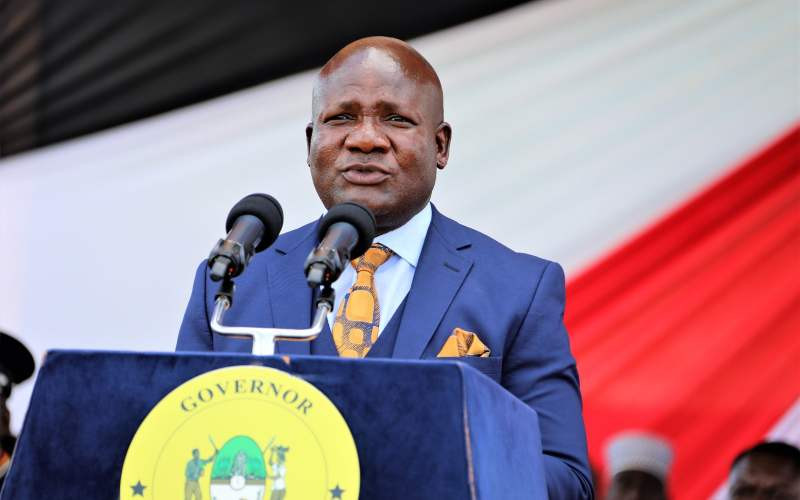By Violet Auma
As Kenya’s political landscape shifts, the battle for Kakamega’s governorship in 2027 is poised to be one of the most fiercely contested races in recent history.
Though the race is still in its early stages, the contenders are emerging, strategies are being refined, and alliances are being tested as the county’s political scene begins to take shape.
In the 2022 election, Fernandes Barasa of the Orange Democratic Movement (ODM) clinched the governorship with a narrow victory, securing 192,929 votes in a contest marked by low voter turnout.
His closest competitor, Cleophas Malala of the Amani National Congress (ANC), garnered 159,508 votes, while the other five candidates trailed far behind.
Former Lugari MP Cyrus Jirongo and Nairobi-based lawyer Michael Osundwa struggled to gain traction, making the race a two-horse contest.
The overall voter turnout stood at just 43 percent, with 361,546 valid votes cast and 2,174 rejected.
Now, as Barasa completes his first term, the contest for Kakamega’s top seat is heating up.
Several high-profile figures have expressed interest in running, including the current Kakamega Senator, Boni Khalwale, and the county’s Woman Representative, Elsie Muhanda, setting the stage for what could be a historic and unpredictable election.
Political analyst Barrack Muluka observes that the political terrain in Kakamega is rapidly shifting.
Many local politicians, sensing growing dissatisfaction with the ruling United Democratic Alliance (UDA) and President William Ruto’s government, are distancing themselves from the national party.
Figures like Khalwale, who also serves as the Senate Majority Chief Whip, are positioning themselves strategically for the gubernatorial race.
According to Muluka, the perception on the ground is that Ruto has not lived up to the expectations of Western Kenya, particularly Kakamega.
“Ruto has failed to honor the promises he made in the charter with the five counties of Western Kenya,” he says. “He was expected to deliver development, but instead, he has been launching county government projects to create the illusion of progress. The more he visits, the more unpopular he becomes.”
Khalwale’s political maneuvering is therefore not just about seeking the governorship but about establishing his political identity amid changing allegiances.
While stepping away from Ruto and UDA might bolster his appeal, it could also leave him vulnerable to accusations of political opportunism.
For Cleophas Malala, who was Barasa’s strongest challenger in 2022, the path to victory in 2027 appears even more uncertain.
Muluka argues that Malala’s close association with former deputy President Rigathi Gachagua could cost him significant support in the region.
“From the beginning, Gachagua has never warmed up to the Mulembe people. His tone and attitude towards the region have been dismissive, and that could cost Malala significant support in the region,” Muluka warns.
Also in the race is the county’s Woman Representative, Elsie Muhanda, who has thrown her hat into the ring, setting the stage for what could be a historic contest.
The question of whether Kakamega is ready for a female governor is gaining momentum, with Elsie Muhanda challenging the county’s male-dominated political history.
While Muhanda’s candidacy represents a potential shift toward gender equality in political leadership, Muluka urges voters to prioritize policies and character over gender.
“It is embarrassing that we rarely elect women to key political positions except for those specifically designated for women,” he says. “Leadership should be about vision and competence, not gender.”
Meanwhile, Governor Barasa finds himself at a crucial juncture as he prepares to defend his seat. His administration has implemented various development projects, but his greatest challenge remains his lack of visibility beyond official platforms.
While his website highlights numerous initiatives, critics argue that his public relations and engagement strategy is insufficient and that politics is not won through websites and press releases.
“If you visit his website, you’ll see plenty of projects listed, but politics is about being on the ground, engaging with the people,” Muluka notes. “Barasa needs to strengthen his communication strategy and ensure he has a stronger physical presence if he hopes to win a second term.”
Further complicating Barasa’s position is the potential entry of his deputy, Ayub Savula, into the 2027 gubernatorial race.
If Savula decides to challenge his boss, it could split votes within the ODM stronghold and force Barasa to rethink his campaign strategy.
With the 2027 elections on the horizon, the race for the Kakamega gubernatorial seat is shaping up to be a battle full of twists and surprises.
New contenders may emerge, alliances may shift, and the landscape may change dramatically in the coming months.
For now, the marbles are still rolling, and as things stand, Kakamega’s political future is on the brink of transformation, and the final picture is far from clear.

